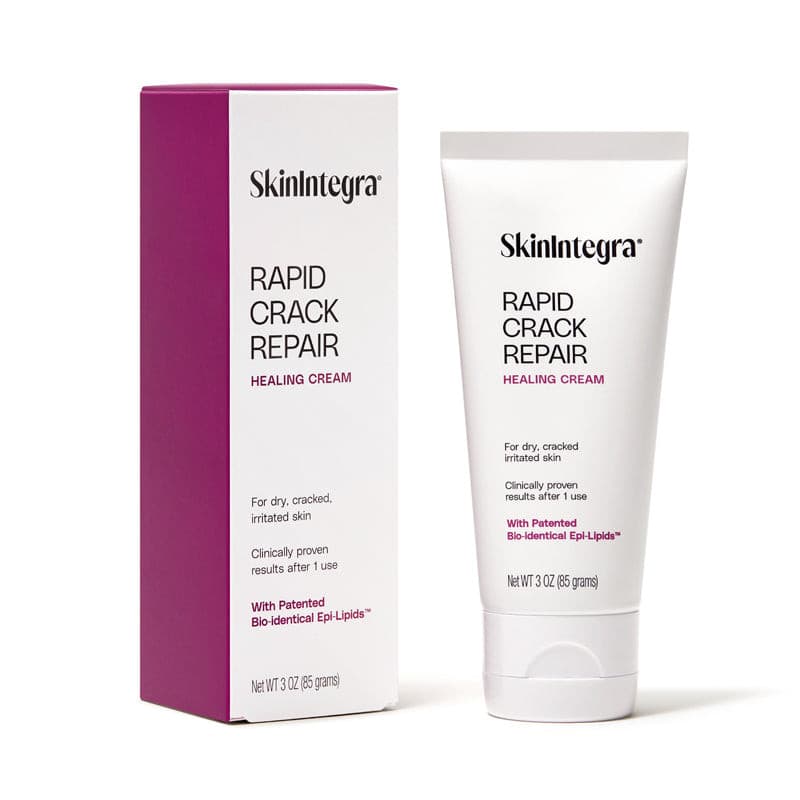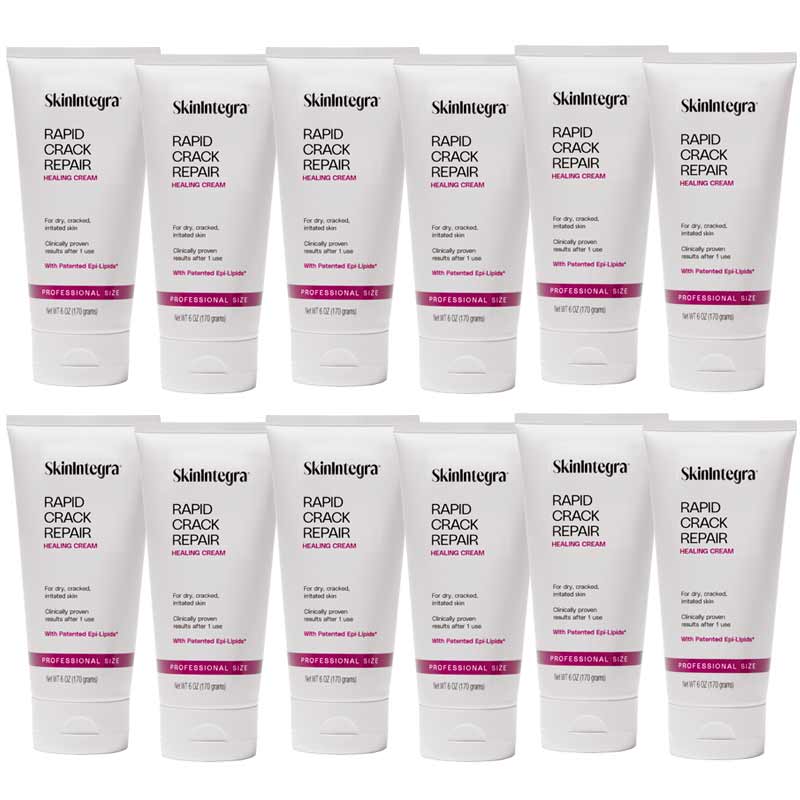Psoriasis on the hands and palms is not only uncomfortable—it can interfere with your daily life. From painful cracks and flaking to thick, scaly patches that affect grip and movement, this condition presents a unique challenge. Understanding its causes, symptoms, and treatment options is key to finding lasting relief and protecting your skin long term.
In this guide, we’ll explain what causes psoriasis on the palms and fingers, how it differs from other forms of the disease, and which treatment options—including barrier-repair creams like SkinIntegra Rapid Crack Repair Cream—can help restore hand comfort and function.
What Is Psoriasis on Palms and Hands?
Palmar psoriasis is a form of plaque psoriasis that appears on the palms and sometimes the fingers. Because your hands are constantly in use, psoriasis in this area is often more difficult to treat than on other parts of the body. The thickened skin and painful cracks may interfere with basic activities like writing, cooking, or using your phone.
Psoriasis on the hands may present with:
-
Red, raised patches with silvery-white scales
-
Hardened, thick skin with fissures or bleeding cracks
-
Dry, inflamed, or itchy skin
-
In some cases, small pustules (palmoplantar pustulosis)
The condition may alternate between flare-ups and remission, and can vary widely in severity between individuals.
What Causes Psoriasis on the Hands?
Psoriasis is an autoimmune condition in which skin cells multiply faster than normal. On the hands and palms, this overproduction leads to the formation of thick, scaly patches. While the exact cause is unknown, several contributing factors are well documented:
Common Triggers Include:
-
Genetics: A family history of psoriasis significantly increases your risk.
-
Stress: Stress is a well-known trigger for hand psoriasis flare-ups.
-
Skin injuries: Cuts, scrapes, burns, or friction may trigger a local response known as the Koebner phenomenon.
-
Infections: Viral or bacterial infections (such as strep throat) can prompt outbreaks.
-
Medications: Lithium, beta-blockers, and antimalarials may worsen psoriasis.
These factors can disrupt immune system balance and provoke inflammation, especially in skin areas with frequent mechanical stress—like your hands.
Why Psoriasis on Hands Is Harder to Treat
Hands are high-contact, high-use areas. Frequent washing, exposure to irritants, and constant motion break down the skin barrier, making it difficult for lesions to heal. Additionally:
-
Fissures may reopen easily, delaying healing
-
Topical treatments rub off quickly, reducing effectiveness
-
Even mild irritation can feel severe due to high nerve sensitivity in the hands
This is why managing hand psoriasis often requires both medical treatment and thoughtful at-home skin protection.
Symptoms of Psoriasis on Hands and Palms
Symptoms can vary, but common signs include:
-
Thickened, scaly patches on the palms or fingers
-
Painful cracks (fissures) that may bleed
-
Dry, inflamed, or peeling skin
-
Burning, itching, or soreness
-
Difficulty grasping objects due to discomfort
Left untreated, the skin may become prone to infection and functional limitation.
How Is Hand Psoriasis Diagnosed?
Diagnosis is typically made through a clinical exam by a dermatologist. Your provider will:
-
Examine the appearance and location of skin lesions
-
Ask about your family history, stress levels, recent illnesses, and medications
-
In some cases, order a skin biopsy to rule out similar conditions (like eczema or fungal infections)
Accurate diagnosis is key to developing an effective, long-term treatment plan.
Treatment Options for Psoriasis on the Hands
There’s no cure for psoriasis, but a combination of topical care, lifestyle adjustments, and clinical treatments can reduce symptoms and prevent flare-ups.
At-Home and Topical Treatments:
-
Moisturize Regularly: Use fragrance-free, lipid-rich moisturizers to reduce dryness and scaling.
-
Avoid Harsh Soaps or Alcohol-Based Sanitizers: These strip the skin barrier and worsen irritation.
-
Barrier Repair Creams: Choose products with urea, lactic acid, hyaluronic acid, and ceramides.
-
Protective Gloves: Use cotton gloves when doing household chores to avoid chemical exposure.
Prescription and Clinical Options:
-
Topical corticosteroids or vitamin D analogs (e.g., calcipotriol)
-
Phototherapy (UVB light treatments) under supervision
-
Systemic medications like methotrexate or biologics for severe cases
Always consult a dermatologist before starting prescription treatments.
Why SkinIntegra Rapid Crack Repair Cream Works for Cracked, Psoriatic Hands

SkinIntegra’s Rapid Crack Repair Cream is specially formulated to help heal cracked, inflamed skin conditions—including those caused by psoriasis and eczema. It’s safe for daily use on sensitive or compromised skin, including hands and palms.
What makes it unique?
-
Exfoliates gently: 25% Urea + lactic acid softens rough, thickened skin
-
Replenishes moisture: Hyaluronic acid draws water into dry areas
-
Restores the barrier: Ceramides, essential fatty acids, and plant oils help rebuild skin integrity
-
Free from irritants: No fragrances, dyes, petroleum, parabens, or phthalates
-
Clinically backed: Patients report visible improvement in cracked hands in just days
In fact, many people with psoriasis on the hands report the first signs of relief within hours of applying SkinIntegra—not days. This fast-acting formula is designed to deliver immediate hydration while working at a deeper level to restore skin structure and comfort.
Unlike generic moisturizers, SkinIntegra is a biomimetic formula—it mimics the natural lipid and hydration profile of healthy skin. That means it gives psoriatic skin exactly what it needs to heal faster and more effectively, without the risk of further irritation.
SkinIntegra is also approved by the American Podiatric Medical Association (APMA) and suitable for those with diabetes-prone or highly sensitive skin.
Shop SkinIntegra Rapid Crack Repair Cream
Looking for a deeper dive into what makes this formula unique? Learn more about how SkinIntegra supports skin barrier repair.
Additional Supportive Care Tips
-
Keep a tube of cream at your bedside and apply at night for overnight repair
-
Apply cream immediately after handwashing
-
Use a humidifier to combat dry indoor air, especially in winter
-
Avoid picking or peeling at flaky areas
For cracked skin in other areas, such as heels, see how to heal cracked heels that bleed safely.
When to See a Dermatologist
Seek professional guidance if:
-
You’re not responding to over-the-counter treatments
-
Cracks begin to bleed, ooze, or become infected
-
You experience new symptoms like nail changes or joint pain
-
Your condition interferes with your ability to work or care for yourself
FAQs: Psoriasis on Hands and Palms
What causes psoriasis on hands and fingers?
A combination of genetics, immune dysregulation, stress, and environmental triggers like injuries or infections.
Is hand psoriasis contagious?
No. Psoriasis is not contagious. It’s an autoimmune condition.
Can SkinIntegra be used on open cracks?
Yes, but only if the skin is intact or has superficial fissures. Avoid applying on actively bleeding or deep open wounds.
Does stress make hand psoriasis worse?
Yes. Stress is one of the most common triggers for flare-ups.
Are there natural remedies that help?
Some people find mild relief from aloe vera or oatmeal soaks, but barrier-repair products offer more targeted support.
Take Control of Psoriasis on Your Hands
You don’t have to suffer through the discomfort of cracked, flaky hands. With a personalized routine that includes gentle cleansing, protective moisturizing, and barrier-repair support, you can minimize flare-ups and live more comfortably.
For long-lasting relief, trust a clinically backed solution like SkinIntegra.
Explore SkinIntegra Rapid Crack Repair Cream Barrier-repair support for dry, cracked, psoriatic skin on hands and feet.





